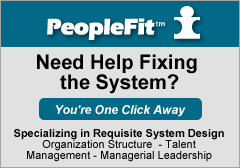Not All Work is Created Equal – Exploring Work Levels 1 through 4
By Michelle Malay Carter on January 1, 2008
 I talk quite a bit about work levels so I thought I would offer a?primer on work levels 1 through 4.? The work levels model provides a universal measurement system for role complexity.? Any role, in any organization, in any industry, in any country can be categorized?by?level.
I talk quite a bit about work levels so I thought I would offer a?primer on work levels 1 through 4.? The work levels model provides a universal measurement system for role complexity.? Any role, in any organization, in any industry, in any country can be categorized?by?level.
Work Levels and Problem Solving Capability Should Be Aligned
Human problem solving capability can be stratified by level as well.? Therefore, someone with current problem solving capability at level 2 will be best suited to work at a level 2 role.? They will be incapable of carrying out the work of a level 3 role.? They will be over-capable for a level 1 role and will likely become bored within 6 months.
Early-Adopter Executives Take Heed for a Competitive Advantage Strategy Suggestion
If organizations?grasped my last paragraph?and operationalized this information into systems for matching employees to roles, principles for organizational design and managerial leadership, much of what ails organizations would fall away.?
Research shows about 35% of employees are mismatched to their roles, and 39% are mismatched to their managers who should have capability one level higher than any direct report.? Mismatches cause dysfunction.
Back to Work Levels
I suggested in my Innovation Snobbery post that?innovation should occur at all levels of the organization, but that innovation will look different at different levels.?
Competencies, as well, look different at different levels.? Competency models are not very useful without stratification.
For example, I may be a successful sales person?at an?entry level sales role in a small company.? Therefore, I have?a sales competency, right?? But not all sales roles are the same.? I’ve closed this post with an example of how sales work would become increasingly complex at higher levels.
Work Levels Defined?
Level 1 Work
Follow a procedure. If that doesn?t work, follow another.? Use a single piece of information to make decisions and solve problems.
Nature of the Problem Solving Embedded in the Work:? Declarative processing: Reasons are given one at a time.? Each one is intended to be sufficient.
Longest Task Deliverable Time Horizon: 1 day to 3 months
Level 2 Work
Accumulating data to draw conclusions from.? Diagnosing a problem from a multi-factor model.
Nature of the Problem Solving Embedded in the Work:? Cumulative processing: A number of reasons are given judged together. It is their sum that makes the case.? A number of factors are considered together to diagnose and solve the problem.
Longest Task Deliverable Time Horizon: 3 months to 1 year
Level 3 Work
Devising one or more paths to get to the solution of a problem
Nature of the Problem Solving Embedded in the Work: Serial processing:? A sequence is built in which A leads to B which leads to C (and possibly beyond).
Longest Task Deliverable Time Horizon: 1 year to 2 years
Level 4 Work
Coordinating and integrating two or more serial paths to get to the solution of a problem.
Nature of the Problem Solving Embedded in the Work:? Parallel processing: ?A system of causal sequences is built in which A leads to B leads to C and a leads a to b leads to c and 1 leads to 2 leads to 3 are all coordinated and integrated to produce the desired output.
Longest Task Deliverable Time Horizon: 2 years to 5 years
Based on the descriptions above, can you figure out the work level of your current role?? If you are a manager, what level of work are you?expecting from your direct reports?
Sample Sales Tasks by Level?
Level 1 Sales Task:? Ask any customer who doesn?t order French fries, if they want fries with the order.? (i.e. Follow a procedure)
Level 2 Sales Task:? Engage your customers in conversation to build a relationship with them. Use the information you accumulate to suggest additional products or services that may suit their needs.? (i.e. Accumulate information and turn it into sales.)
Level 3 Sales Task:? Create a process for obtaining referrals, contacting them, selling them, and using them to generate more referrals. At the end of 14 months, have a referral pipeline established that will generate a minimum of X in annual sales.? (i.e. Create a serial process.)
Level 4 Sales Task:? Expand our sales footprint beyond the US by establishing a sales force in Mexico which should be responsible for 15% of total sales at the end of four years.? (i.e. Integrate multiple serial pathways:? recruiting, staffing, facilities, technology, Mexican human resource law and customs, customer identification, sales process, product offerings, marketing, advertising, operations, delivery, warehousing. etc.)
Cheaper and More Useful Than an MBA
I daresay that acting upon this one little post could do more to help an executive successfully lead an organization than anything s/he learned at MBA school.? Unfortunately, I don’t know of any MBA school that teaches work levels theory or its meta model, Requisite Organization developed by Elliott Jaques.
Do You have an MBA?? Have you every heard of work levels or Requisite Organization??
Filed Under Executive Leadership, Organization Design, Requisite Organization, Talent Management
Comments
10 Responses to “Not All Work is Created Equal – Exploring Work Levels 1 through 4”

[…] is Related to Work Levels Time span of discretion is the way to scientifically measure the work levels I love to chat about on this blog.? I usually talk about work levels in a descriptive manner so that my readers can get […]
[…] Four Work Example An example of level four work I offered in a previous post was:? Expand our sales footprint beyond the US by establishing a sales force in Mexico which […]
[…] in reality, it would have been in the best interest of everyone to hire over this person.? Someone level 4+ capable, i.e. strategic capability, to design, implement and improve the purchasing […]
[…] As Easy As 1, 2, 3 When we understand some scientific basics about work levels and human capability, we can apply that knowledge toward effective design.? This is what engineers […]
[…] Your Work Levels Of course, I suggest using a work levels approach to describing the work.? Why?? Because if you were to accurately describe a level-four sales role […]
[…] we don’t really understand work levels or human cognitive capability?in terms of levels, what do you think the probability is that we […]
[…] All Roles Are Created Equal I’ve said before that not all roles are created equal.? For example, CEO roles can be found from work level 3, a small,?local organization (a […]
[…] ExtraPlay #1: Michelle Malay Carter has written a concise and extremely useful post on how to think about job fit … […]
Michelle has generated a wonderful idea which needs to be evolved as we go along. Nothing is perfect and so are processes and methods. But I find a great clue for mapping competencies more accurately.
Hi Dhruva,
I wish I could take credit for the underlying theory but it is of Elliott Jaques. It is one part of his meta-model, Requisite Organization. The examples are mine.
Michelle